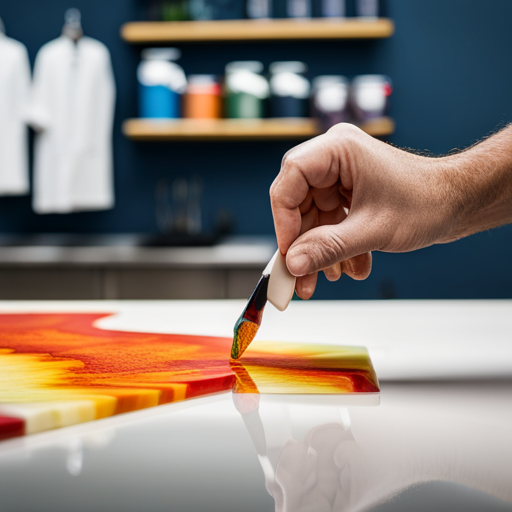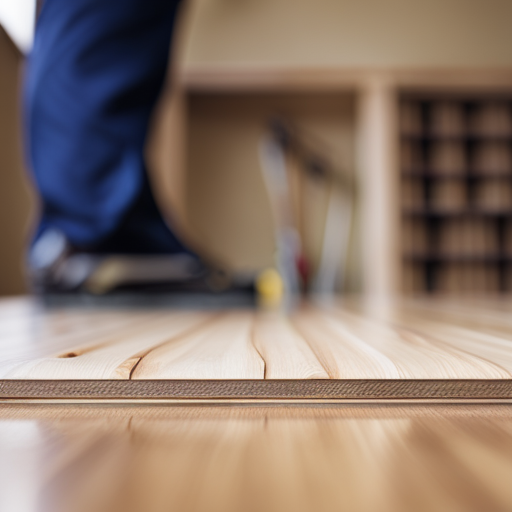
This article provides a comprehensive guide on repairing quartz countertop chips. The objective of this academic-style writing is to offer precise and knowledgeable information while maintaining an impersonal tone.
By following the steps outlined in this guide, readers will gain a thorough understanding of how to:
- Assess damage
- Gather necessary supplies
- Clean and prepare the area
- Apply epoxy resin
- Smooth and level the surface
- Sand and polish the area
- Apply a protective sealant
- Maintain their countertops
- Prevent future damage
- Seek professional help if needed.
Assessing the Damage
The first step in the process of repairing a quartz countertop chip involves carefully assessing the extent of the damage. This is crucial as it allows homeowners to evaluate their options and determine the most appropriate course of action. Evaluating the extent of the damage involves examining the size, depth, and location of the chip. A small, shallow chip may be easier to repair compared to a larger or deeper one.
When assessing the damage, it is important to consider whether there are any underlying issues that contributed to the chip. For example, if there is an issue with the installation or support structure of the countertop, simply repairing the chip may not be sufficient in preventing future damage. In such cases, it may be necessary to address these underlying issues as part of the repair process.
Another factor to consider when evaluating options for repairing a quartz countertop chip is cost. The cost of repair can vary depending on factors such as the size and severity of the damage, as well as whether professional assistance is required. It is recommended that homeowners obtain quotes from reputable contractors or professionals experienced in quartz countertop repairs before making a decision.
Overall, careful assessment of the damage is essential when considering how to repair a quartz countertop chip. By thoroughly evaluating options and considering factors such as cost, homeowners can make informed decisions that prioritize safety and ensure effective repairs are carried out.
## Gathering the Necessary Supplies
To successfully gather the necessary supplies for addressing a chipped area on a quartz countertop, one should consider obtaining materials such as epoxy filler, fine-grit sandpaper, and a putty knife. These items play a crucial role in effectively repairing the damaged surface. Here are some tips for DIY quartz countertop repair:
1. Epoxy filler: This material is essential for filling in the chip and restoring the smoothness of the countertop surface. It provides durability and strength to withstand daily use.
2. Fine-grit sandpaper: Using fine-grit sandpaper allows for precise smoothing of the repaired area. It helps to blend the epoxy filler with the surrounding quartz surface seamlessly.
3. Putty knife: A putty knife is necessary for applying and shaping the epoxy filler onto the chipped area accurately. Its flat edge ensures even distribution of the filler and enables smooth finishing.
4. Safety precautions: When working with these supplies, it is important to wear safety goggles and gloves to protect your eyes and hands from any potential harm during the repair process.
## Cleaning and Preparing the Area
Cleaning and preparing the area involves removing any debris or dirt from the damaged surface in order to ensure proper adhesion of the epoxy filler. Before applying any repair materials, it is crucial to thoroughly clean the chipped area. This can be done using mild soap and warm water, gently scrubbing the surface with a non-abrasive sponge or cloth. Care should be taken not to use harsh chemicals or abrasive cleaners, as they may cause further damage to the countertop.
Once cleaned, it is important to dry the area completely before proceeding with the repair process. Any moisture left on the surface can interfere with the adhesion of the epoxy filler, compromising its effectiveness. A lint-free cloth or paper towel can be used to carefully dry the countertop.
In addition to cleaning techniques, there are also methods that can help prevent future damage to quartz countertops. Using cutting boards and trivets when working with sharp objects or hot items can protect against scratches and heat damage. Avoiding heavy impact on the countertop by refraining from dropping heavy objects onto it is also advisable.
## Applying the Epoxy Resin
Applying the epoxy resin involves carefully spreading a thin layer of the filler across the damaged surface, ensuring even coverage. This step is crucial to achieve a successful repair of a quartz countertop chip.
To ensure an effective application, it is important to follow certain tips and techniques.
Firstly, it is essential to prepare the epoxy resin according to the manufacturer’s instructions. This typically involves mixing two components together in a specific ratio. Accurate measurement and thorough mixing are necessary to ensure proper curing and durability of the repaired area.
When applying the epoxy resin, using a small putty knife or spatula can help achieve precise spreading and control over the amount of filler applied. It is advisable to work in small sections, gradually building up layers if needed.
One common mistake to avoid when applying epoxy resin is overfilling the chip or crack. Excess filler may result in an uneven surface or create difficulties during sanding and polishing stages.
Another mistake often made is failing to remove any excess resin immediately after application. If left unattended, hardened excess resin can be difficult to remove and may affect the appearance of the repaired area.
## Smoothing and Leveling the Surface
Smoothing and leveling the surface requires careful attention to detail in order to achieve a seamless finish. When repairing chips or filling voids on a quartz countertop, it is crucial to follow proper procedures to ensure both aesthetic appeal and safety.
To begin, gather the necessary materials such as epoxy resin, a putty knife, sandpaper, and a clean cloth. Start by cleaning the damaged area with mild soap and water, removing any debris or dirt that may interfere with the repair process.
Next, mix the epoxy resin according to the manufacturer’s instructions. Apply a thin layer of resin over the chipped or voided area using a putty knife, ensuring it is evenly spread out. Allow it to dry completely before proceeding further.
Once dry, use sandpaper to carefully smooth down any rough edges until they are level with the surrounding countertop surface. Take caution not to apply excessive pressure that could cause further damage.
After smoothing down the repaired area, wipe away any dust or residue using a clean cloth. Inspect the surface for any imperfections and repeat the process if necessary until achieving a flawless finish.
## Curing and Drying the Repair
During the curing and drying process, it is important to ensure that the repaired area is not disturbed or exposed to moisture in order to achieve optimal results. The following drying techniques should be followed to ensure the best possible outcome:
– Keep the repaired area covered with a plastic sheet or masking tape to protect it from dust, debris, and accidental contact.
– Maintain a controlled environment by avoiding exposure to extreme temperatures or humidity levels.
Allow sufficient curing time as specified by the manufacturer’s instructions. This may vary depending on the type of repair material used.
– Avoid applying any pressure or weight on the repaired area until it has completely dried and cured. This will prevent any potential damage or distortion.
– Regularly inspect the repaired area during the drying process for any signs of cracking, shrinking, or discoloration. If observed, take appropriate measures such as reapplication of repair material.
Following these drying techniques and adhering to recommended curing times will help ensure that your quartz countertop chip repair is successful and long-lasting.
## Sanding and Polishing the Area
Sanding and polishing the area requires careful attention to detail in order to achieve a smooth and glossy finish. After applying the repair material and allowing it to cure, it is important to prepare the repaired area for blending with the surrounding countertop surface. This involves sanding down any excess material until it is level with the rest of the countertop. It is crucial to use fine-grit sandpaper and apply even pressure during this process to avoid creating further damage or unevenness.
Once the repaired area has been sanded down, polishing can begin. Polishing helps to restore the shine and luster of the countertop surface. A buffing pad or cloth can be used along with a suitable polishing compound to gently buff the repaired area. It is essential to follow proper safety precautions when working with chemicals by wearing gloves and ensuring adequate ventilation.
Color matching and blending are also critical aspects of achieving a seamless repair on a quartz countertop chip. To ensure an accurate color match, samples of different shades can be tested on inconspicuous areas before applying them directly onto the repaired spot. Blending techniques such as feathering can help soften any visible edges between the repaired section and its surroundings.
## Applying a Protective Sealant
Transition: After successfully sanding and polishing the chipped area of your quartz countertop, the next step is to apply a protective sealant. This final step will not only enhance the appearance of the repaired area but also provide long-lasting protection against future damage. In this current subtopic, we will explore various protective sealant alternatives for quartz countertops and discuss the pros and cons of sealant application.
To help you make an informed decision, let’s examine a table that highlights four commonly used protective sealants for quartz countertops:
| Sealant Type | Pros | Cons |
| ————– | ————————————- | ———————————————— |
| Epoxy Resin | Excellent durability and heat resistance | Requires careful application due to quick drying time |
| Silicone | Easy to apply and provides good water resistance | May require reapplication over time |
| Polyurethane | Offers excellent stain resistance | Not as heat resistant as other sealants |
| Acrylic | Provides good overall protection | May need frequent reapplication |
It is important to note that each type of sealant has its own set of advantages and disadvantages. Consider your specific needs, such as heat or stain resistance, before choosing a protective sealant for your quartz countertop. Additionally, ensure that you carefully follow the manufacturer’s instructions for proper application to achieve optimal results.
## Maintaining and Preventing Future Damage
To ensure the long-term durability and appearance of a sealed quartz surface, regular maintenance and preventative measures are essential. Quartz countertops are known for their strength and resistance to stains, but proper care is still necessary to maintain their pristine condition.
Here are some important steps to consider when maintaining your quartz countertop:
– Clean spills immediately: Wipe up any spills as soon as possible to prevent them from seeping into the porous surface of the quartz. This will help prevent stains from setting in.
– Avoid abrasive cleaners: Use non-abrasive cleaning products specifically designed for quartz countertops. Harsh chemicals or scrubbing brushes can damage the surface of the quartz, leading to potential discoloration or scratching.
– Use gentle cleaning techniques: When cleaning your countertop, use a soft cloth or sponge along with a mild detergent or stone cleaner. Gently wipe away any dirt or debris without applying excessive pressure.
– Protect against heat and scratches: Always use trivets or hot pads under hot pots, pans, or appliances to protect your quartz countertop from heat damage. Additionally, use cutting boards when preparing food to prevent scratches on the surface.
## Seeking Professional Help
Seeking professional assistance is advisable when dealing with any damage or issues that may arise with a quartz surface. Hiring experts who specialize in repairing quartz countertops ensures that the job is done correctly and safely. When choosing professionals, it is important to consider their expertise, reputation, and experience in working with quartz surfaces.
A reputable professional will have the necessary knowledge and skills to assess the damage and determine the appropriate repair method. They will also have access to specialized tools and materials required for the task. By hiring a professional, you can be confident that the repair work will be carried out efficiently, minimizing the risk of further damage or complications.
To illustrate the benefits of hiring experts for quartz countertop repairs, consider the following table:
| Benefits of Hiring Professionals for Quartz Countertop Repairs |
|—————————————————————|
| Expertise in working with quartz surfaces |
| Knowledge of various repair methods |
| Access to specialized tools and materials |
| Efficient and safe repair work |
| Minimization of further damage or complications |
## Frequently Asked Questions
### Can I use regular household cleaners to clean and prepare the area before repairing a quartz countertop chip?
Household cleaner alternatives should be avoided when cleaning and preparing the area before repairing a quartz countertop chip. These cleaners may contain harsh chemicals that could potentially damage the countertop further. To prevent future chips, it is recommended to use cutting boards or trivets when placing hot objects on the countertop and to avoid using sharp tools directly on the surface.
### How long does it typically take for the epoxy resin to fully cure and dry after applying it to the chipped area?
The epoxy resin used for repairing a quartz countertop chip typically takes around 24 to 48 hours to fully cure and dry. It is important to use the best cleaners specifically designed for quartz countertop chip repair.
### Can I use any type of sandpaper to sand and polish the repaired area, or is there a specific type that works best for quartz countertops?
Sanding techniques for repairing quartz countertops typically involve using fine-grit sandpaper, such as 220 or higher. It is important to avoid using rough sandpaper, as it may scratch the surface. Alternative repair methods include using a resin-based filler or contacting a professional for assistance.
### How often should I apply a protective sealant to my quartz countertop to prevent future damage?
To maintain the shine of a quartz countertop without sealant, alternative methods include regular cleaning with non-abrasive cleaners, using cutting boards and trivets, and avoiding exposure to high temperatures. These measures help prevent damage and preserve the countertop’s appearance.
### What is the average cost of seeking professional help to repair a quartz countertop chip?
The average cost of seeking professional help to repair a quartz countertop chip can vary depending on the extent of the damage and the location. DIY options are available for those who prefer to save costs, but may not guarantee the same level of expertise.
## Conclusion
In conclusion, repairing a quartz countertop chip requires careful assessment of the damage, gathering the necessary supplies, and cleaning and preparing the area.
The application of epoxy resin is crucial to fill in the chip, followed by smoothing and leveling the surface.
Sanding and polishing help achieve a seamless finish, while applying a protective sealant ensures long-lasting durability.
It is important to maintain and prevent future damage through regular maintenance practices.
If unsure or unable to complete the repair yourself, seeking professional help is recommended for optimal results.


